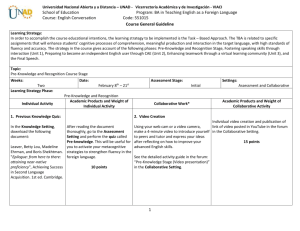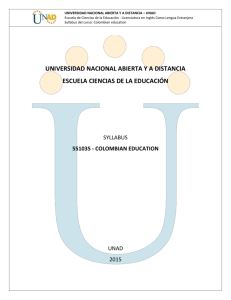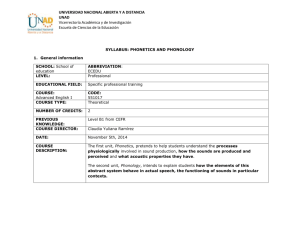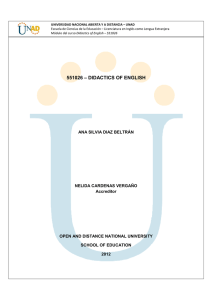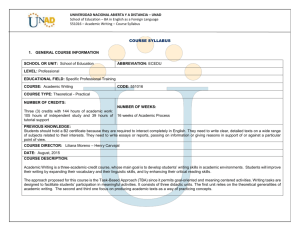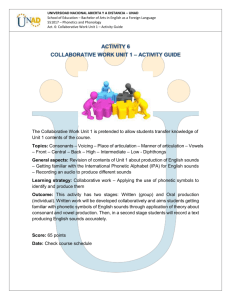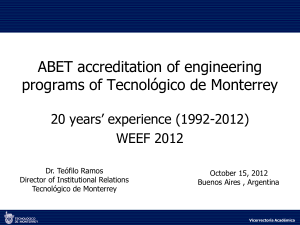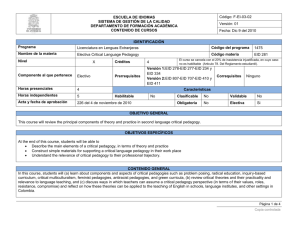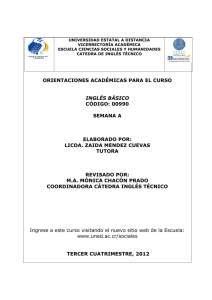assignment1
advertisement
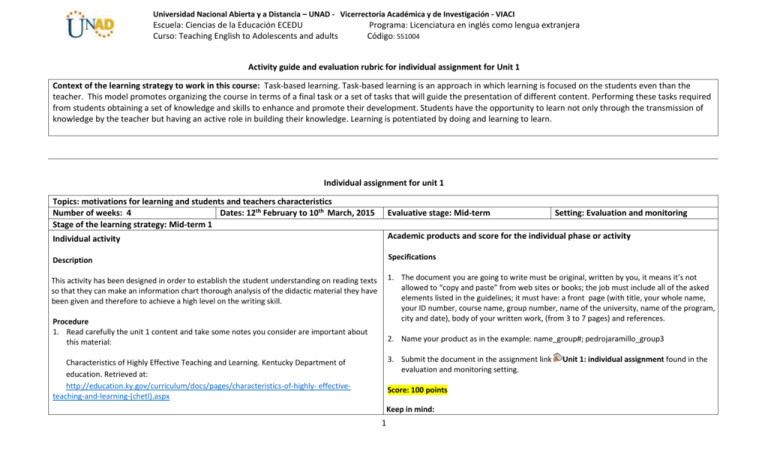
Universidad Nacional Abierta y a Distancia – UNAD - Vicerrectoría Académica y de Investigación - VIACI Escuela: Ciencias de la Educación ECEDU Curso: Teaching English to Adolescents and adults Programa: Licenciatura en inglés como lengua extranjera Código: 551004 Activity guide and evaluation rubric for individual assignment for Unit 1 Context of the learning strategy to work in this course: Task-based learning. Task-based learning is an approach in which learning is focused on the students even than the teacher. This model promotes organizing the course in terms of a final task or a set of tasks that will guide the presentation of different content. Performing these tasks required from students obtaining a set of knowledge and skills to enhance and promote their development. Students have the opportunity to learn not only through the transmission of knowledge by the teacher but having an active role in building their knowledge. Learning is potentiated by doing and learning to learn. Individual assignment for unit 1 Topics: motivations for learning and students and teachers characteristics Number of weeks: 4 Dates: 12th February to 10th March, 2015 Stage of the learning strategy: Mid-term 1 Evaluative stage: Mid-term Individual activity Academic products and score for the individual phase or activity Description Specifications This activity has been designed in order to establish the student understanding on reading texts so that they can make an information chart thorough analysis of the didactic material they have been given and therefore to achieve a high level on the writing skill. 1. The document you are going to write must be original, written by you, it means it’s not allowed to “copy and paste” from web sites or books; the job must include all of the asked elements listed in the guidelines; it must have: a front page (with title, your whole name, your ID number, course name, group number, name of the university, name of the program, city and date), body of your written work, (from 3 to 7 pages) and references. Procedure 1. Read carefully the unit 1 content and take some notes you consider are important about this material: Setting: Evaluation and monitoring 2. Name your product as in the example: name_group#; pedrojaramillo_group3 3. Submit the document in the assignment link evaluation and monitoring setting. Characteristics of Highly Effective Teaching and Learning. Kentucky Department of education. Retrieved at: http://education.ky.gov/curriculum/docs/pages/characteristics-of-highly- effectiveteaching-and-learning-(chetl).aspx Score: 100 points Keep in mind: 1 Unit 1: individual assignment found in the Universidad Nacional Abierta y a Distancia – UNAD - Vicerrectoría Académica y de Investigación - VIACI Escuela: Ciencias de la Educación ECEDU Curso: Teaching English to Adolescents and adults Programa: Licenciatura en inglés como lengua extranjera Código: 551004 The needs and motivations of learning. A guest post by Caitlin Bloom, Deputy President • Students that don’t submit this written job during the established dates will get a zero (0.0) education at De Montford Students' Union. Retrieved at: as score for this activity. http://www.nusconnect.org.uk/blogs/blog/rachelwenstone/2013/02/08/The-needs-andmotivations-of-learning/ • The participation and the product will be assessed according to the evaluation rubric. How Motivation Affects Learning and Behavior. Retrieved at: http://www.education.com/reference/article/motivation-affects-learning-behavior/ • Students submitting products from other classmates, as a plagiarism will get a zero (0.0) as score. Learning styles and teaching Submitted by TE Editor on 8 September, 2010. Retrieved at: http://www.teachingenglish.org.uk/articles/learning-styles-teaching 2. Make a concept map in which you show how motivation affects learning and the learning styles we can find in our students. 3. According to the teaching styles, choose one strategy you can use with teenagers and one with adults. Plan one activity for each one of the chosen strategies, explaining the stages of development of the activity (pre, while, post). *guidelines for collaborative work Activities planning for the collaborative work Roles for the collaborative work Roles and responsibilities for the students’ products delivery This is an individual activity, so there are not activities planned for collaborative work. Teacher’s recommendation: It is important that you take into account these recommendations: Read very carefully all the instructions given in each one of the activities proposed in this course. Try to participate in each activity on time. This will dynamize the group’s participation in each one of the collaborative forums. 2 Universidad Nacional Abierta y a Distancia – UNAD - Vicerrectoría Académica y de Investigación - VIACI Escuela: Ciencias de la Educación ECEDU Curso: Teaching English to Adolescents and adults Programa: Licenciatura en inglés como lengua extranjera Código: 551004 Remember that in collaborative assignments, if you participate for the first time in the end of deadline (the day before the due date and the due date), you will be only evaluated in your individual participation. Uso de la norma APA, versión 3 en español (Traducción de la versión 6 en inglés Políticas de plagio: ¿Qué es el plagio para la UNAD? El plagio está definido por el diccionario de la Real Academia como la acción de "copiar en lo sustancial obras ajenas, dándolas como propias". Por tanto el plagio es una falta grave: es el equivalente en el ámbito académico, al robo. Un estudiante que plagia no se toma su educación en serio, y no respeta el trabajo intelectual ajeno. No existe plagio pequeño. Si un estudiante hace uso de cualquier porción del trabajo de otra persona, y no documenta su fuente, está cometiendo un acto de plagio. Ahora, es evidente que todos contamos con las ideas de otros a la hora de presentar las nuestras, y que nuestro conocimiento se basa en el conocimiento de los demás. Pero cuando nos apoyamos en el trabajo de otros, la honestidad académica requiere que anunciemos explícitamente el hecho que estamos usando una fuente externa, ya sea por medio de una cita o por medio de un paráfrasis anotado (estos términos serán definidos más adelante). Cuando hacemos una cita o un paráfrasis, identificamos claramente nuestra fuente, no sólo para dar reconocimiento a su autor, sino para que el lector pueda referirse al original si así lo desea. Existen circunstancias académicas en las cuales, excepcionalmente, no es aceptable citar o parafrasear el trabajo de otros. Por ejemplo, si un docente asigna a sus estudiantes una tarea en la cual se pide claramente que los estudiantes respondan utilizando sus ideas y palabras exclusivamente, en ese caso el estudiante no deberá apelar a fuentes externas aún, si éstas estuvieran referenciadas adecuadamente. Para mayor información visitar el siguiente link: http://datateca.unad.edu.co/contenidos/434206/ContenidoLinea/seccin_2313_poltica_sobre_el_plagio.html 3 Universidad Nacional Abierta y a Distancia – UNAD - Vicerrectoría Académica y de Investigación - VIACI Escuela: Ciencias de la Educación ECEDU Programa: Licenciatura en inglés como lengua extranjera Curso: Teaching English to Adolescents and adults Código: 551004 EVALUATION RUBRIC FOR THE UNIT 1 ASSIGNMENT Evaluated Ítem Concepts and terminology of the concept map Low score You made many mistakes in terminology and showed a lack of understanding of many concepts. Your map showed no understanding of the topic’s concepts and principles. (2 Points) Medium score You made some mistakes in terminology or shows a few misunderstanding of concepts. (10 Points) High score Your map shows an understanding of the topic’s concepts and principles and uses appropriate terminology and notations (20 Points) Knowledge of the relationship among concepts You made many incorrect connections or failed You identified many important concepts but to use any appropriate concepts or made some incorrect connections. connections. (10 Points) (2 Points) You identified all the important concepts and showed an understanding of the relationships among them. (20 Points) Ability to communicate through concept maps You placed only a few concepts in an appropriated hierarchy or uses only a few linking words. You produced a concept map that is difficult to interpret. (2 points) You placed almost all concepts in an appropriate hierarchy and assigns linking words to most connections. (10 points) You constructed an appropriate and complete concept map in which you placed concepts in an appropriate hierarchy and places linking words on all connections. (20 points) Planning of activities The student didn’t plan any activity for the chosen strategies for teaching English to adolescents and adult. (0 Points) The student only planned one of the 2 activities according to the chosen strategies, or planned the 2 activities but the stages of development are not completed or are not specified. (12 Points) The student planned 2 activities, one for each one of the strategies chosen to teach English to adolescents and adults. In both plans it is explained the stages of development of the activity (pre-while-post) (25 Points) 4 Total Score 20 20 20 25 Universidad Nacional Abierta y a Distancia – UNAD - Vicerrectoría Académica y de Investigación - VIACI Escuela: Ciencias de la Educación ECEDU Curso: Teaching English to Adolescents and adults Document format and Structure The student didn’t submit the document in which he/she presents the concept map and the 2 activities for the chosen strategies to teach English to adolescents and adults Programa: Licenciatura en inglés como lengua extranjera Código: 551004 The document is not complete, the information is irrelevant or its structure does not fit the established requirements given on the guidelines. (7 Points) The student submitted the document in which he/she present the concept map and the 2 activities for the chosen strategies to teach English to adolescents and adults. (15 Points) 15 (0 Points) TOTAL 100 5
